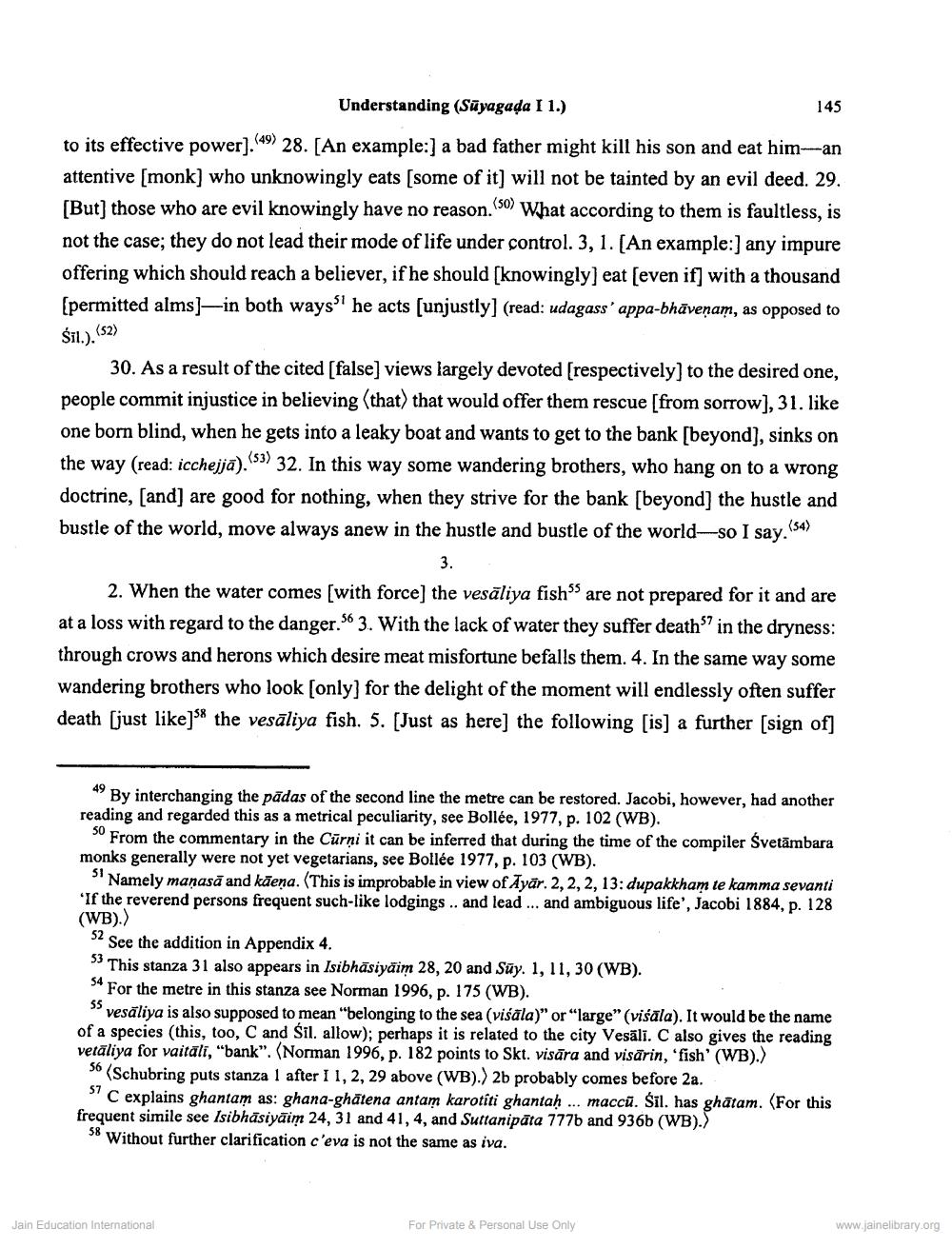________________
Understanding (Sayagaḍa I 1.)
(49)
(50)
to its effective power], 28. [An example:] a bad father might kill his son and eat him--an attentive [monk] who unknowingly eats [some of it] will not be tainted by an evil deed. 29. [But] those who are evil knowingly have no reason. What according to them is faultless, is not the case; they do not lead their mode of life under control. 3, 1. [An example:] any impure offering which should reach a believer, if he should [knowingly] eat [even if] with a thousand [permitted alms]-in both ways" he acts [unjustly] (read: udagass' appa-bhaveṇam, as opposed to SIL.), (52)
30. As a result of the cited [false] views largely devoted [respectively] to the desired one, people commit injustice in believing (that) that would offer them rescue [from sorrow], 31. like one born blind, when he gets into a leaky boat and wants to get to the bank [beyond], sinks on the way (read: icchejjā). (53) 32. In this way some wandering brothers, who hang on to a wrong doctrine, [and] are good for nothing, when they strive for the bank [beyond] the hustle and bustle of the world, move always anew in the hustle and bustle of the world-so I say. (54)
145
3.
2. When the water comes [with force] the vesäliya fish" are not prepared for it and are at a loss with regard to the danger." 3. With the lack of water they suffer death" in the dryness: through crows and herons which desire meat misfortune befalls them. 4. In the same way some wandering brothers who look [only] for the delight of the moment will endlessly often suffer death [just like the vesaliya fish. 5. [Just as here] the following [is] a further [sign of]
49
By interchanging the padas of the second line the metre can be restored. Jacobi, however, had another reading and regarded this as a metrical peculiarity, see Bollée, 1977, p. 102 (WB).
50 From the commentary in the Curni it can be inferred that during the time of the compiler Svetambara monks generally were not yet vegetarians, see Bollée 1977, p. 103 (WB).
51 Namely manasa and käena. (This is improbable in view of Ayar. 2, 2, 2, 13: dupakkham te kamma sevanti 'If the reverend persons frequent such-like lodgings.. and lead... and ambiguous life', Jacobi 1884, p. 128 (WB).)
See the addition in Appendix 4.
53 This stanza 31 also appears in Isibhāsiyāim 28, 20 and Suy. 1, 11, 30 (WB).
54
For the metre in this stanza see Norman 1996, p. 175 (WB).
55
vesaliya is also supposed to mean "belonging to the sea (visala)" or "large" (visala). It would be the name of a species (this, too, C and Sil. allow); perhaps it is related to the city Vesali. C also gives the reading vetaliya for vaitāli, "bank". (Norman 1996, p. 182 points to Skt. visāra and visarin, 'fish' (WB).)
56 (Schubring puts stanza 1 after I 1, 2, 29 above (WB).) 2b probably comes before 2a.
57 C explains ghantam as: ghana-ghatena antam karotiti ghantaḥ... maccu. Šil. has ghātam. (For this frequent simile see Isibhāsiyaim 24, 31 and 41, 4, and Suttanipata 777b and 936b (WB).) 58 Without further clarification c'eva is not the same as iva.
Jain Education International
For Private & Personal Use Only
www.jainelibrary.org




